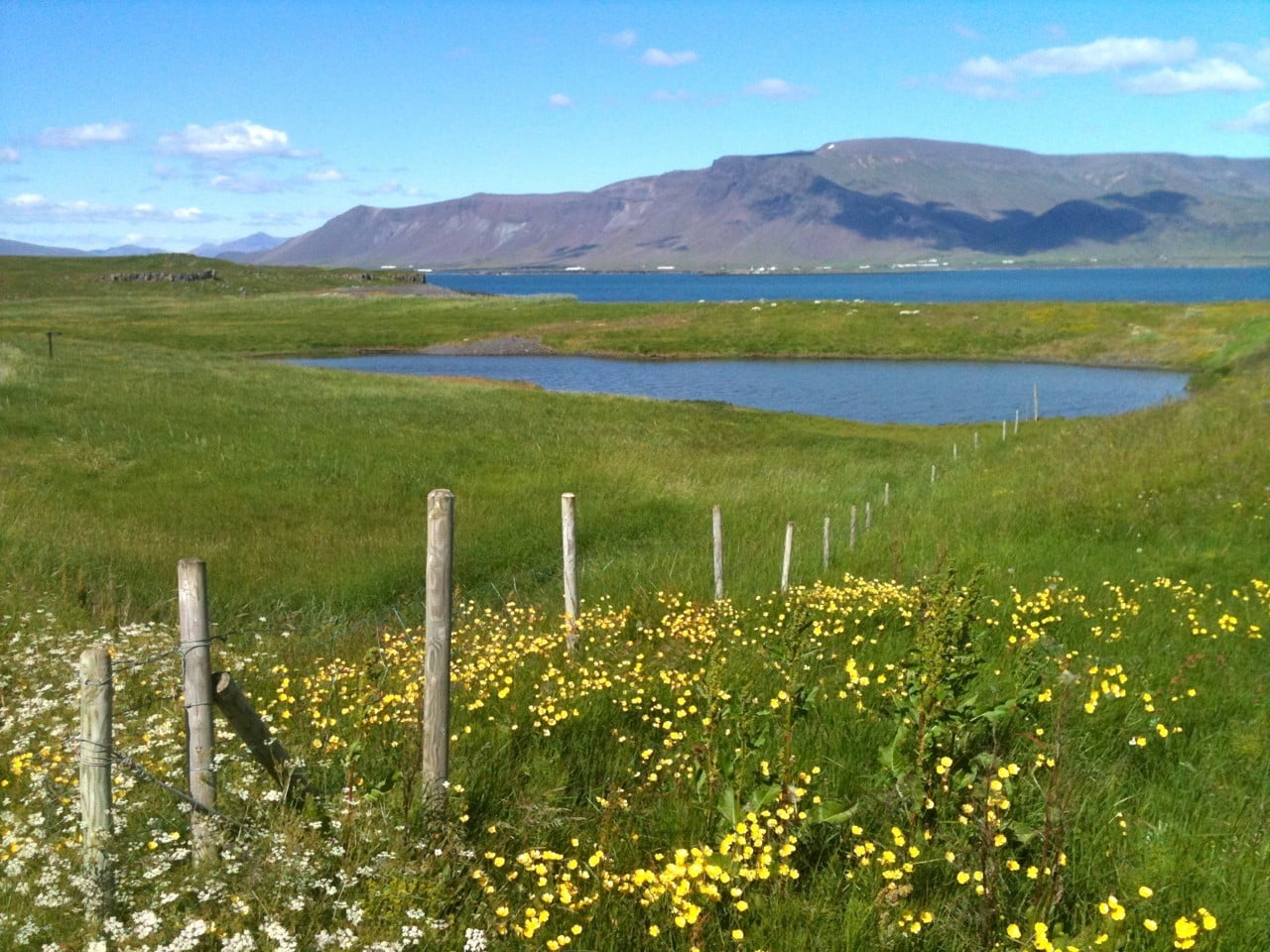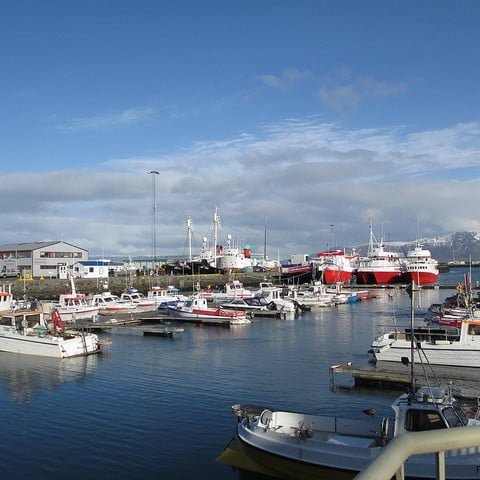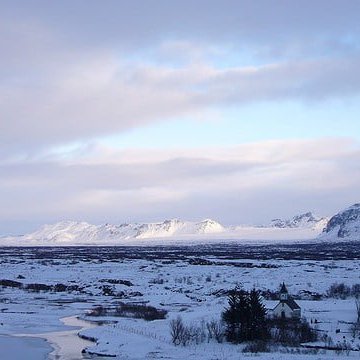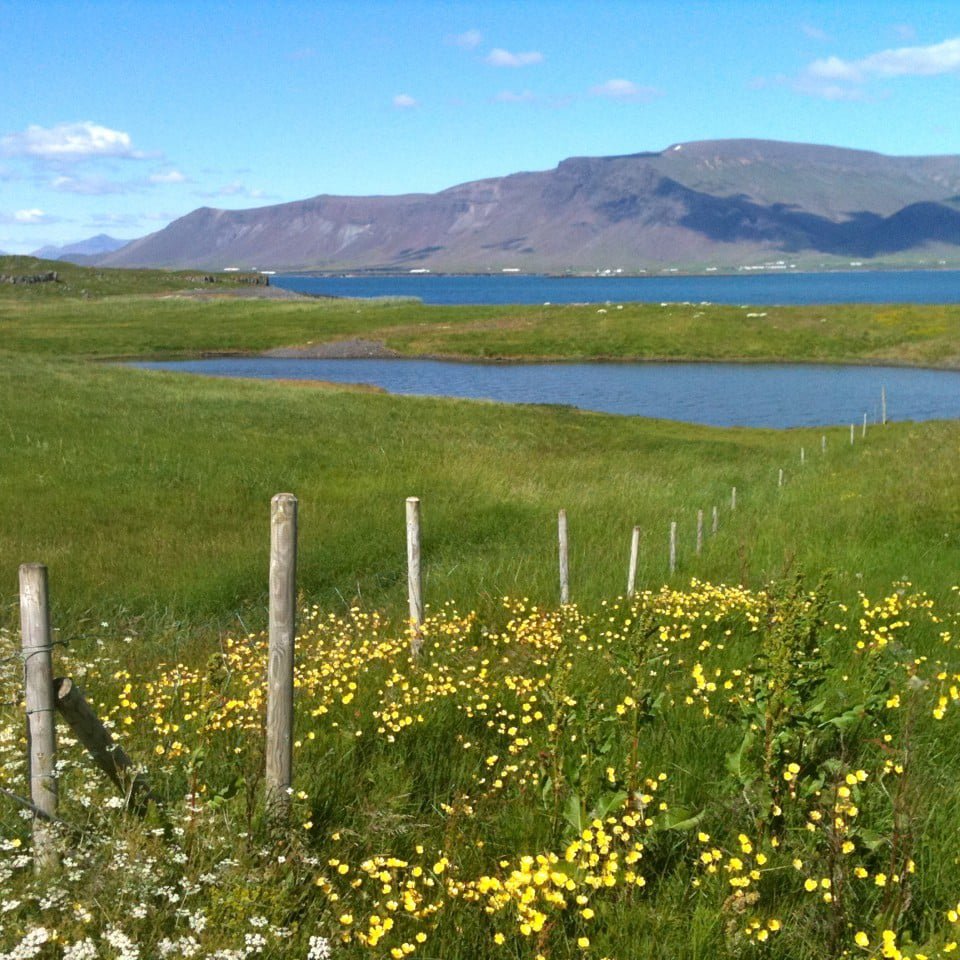Weather in August in Iceland
It’s a real pleasure to be in Iceland in August. There’s an abundance of sun throughout the summer months, and by August, nature responds with a show of bright and verdant green. It’s the perfect time to explore.
In this guide, you’ll learn what to expect from the weather in August in Iceland. And we’ll share some of the most rewarding activities to get up to.
What to expect from Iceland’s August weather
August comes at the end of Icelandic summer. While it’s not as bright as it was earlier in May, June, and July, August tends to be warm and dry. Here’s what you can expect from the weather this month.
What are the daylight hours in Iceland in August?
In August in Iceland, it’s still possible to enjoy long evenings of sunshine, even if the summer solstice is long behind us. In Reykjavík, in southwest Iceland, on 1 August, the sun rises at 04:36 and sets at 22:29. That gives you about 18 hours of daylight to play with each day, but the daylight hours reduce throughout the month. By 31 August, the sun rises at 06:08 and sets at 20:45. That means just over 14 hours of daylight.
This month, even if you venture north, you won’t find much more daylight as you would earlier in the summer. In Akureyri, for instance, the sun rises at 04:03 and sets at 22:30 on 1 August. By 31 August, it rises at 05:47 and sets at 20:35.
What’s the temperature in Iceland in August?
The temperature in Iceland will depend on where you are in the country. But generally speaking, August is one of the warmest months of the year. In Reykjavík, average highs are 14.1°C (57.4°F), while average lows are 8.6°C (47.5°F). Of course, these are just averages, and temperatures are known to have reached 24.8°C (76.6°F) and –0.4°C (31.3°F).
It’s a large range, meaning that it’s smart to bring lots of layers when visiting Iceland in August. You’ll definitely want something warm to wear in the evening. That’s true also in Akureyri, the “Capital of the North”. Here, average highs in August are 14.8°C (58.6°F), and lows are 7.9°C (46.2°F). But the temperatures in the north tend to be more extreme, having reached 27.7°C (81.9°F) and as low as –2.2°C (28°F).
How much rain does Iceland get in August?
Typically, in Iceland, the south is the rainiest part of the country, with the north enjoying a generally drier climate. For instance, the village of Vík í Mýrdal on the south coast typically experiences five times as much rain as Akureyri in the north.
This is true in August too. For instance, Reykjavík receives an average of 64.5mm (2.54 inches) of rain throughout August, which typically falls over 11.6 days (meaning you have just under 20 August days that should be dry in the capital). Compare that to Akureyri, which receives 41.4mm (1.63 in) of rain in August over an average of 8.1 days. So, overall, you should expect a bit of rain on one in every four or one in every three days that you stay in Iceland in August. It’s definitely worth bringing a jacket!
What to do in Iceland in August (whether there’s rain or sunshine)
While Iceland has a reputation for bad weather, in August there’s plenty of sunshine too. Here are our suggestions of four things to do to enjoy the weather—and have a good time no matter what happens.
1. Join one of Iceland’s August festivals and events
In August, Iceland has an action-packed cultural calendar. On your visit to the country, take part in one of these awe-inspiring events:
- Innipúkinn Music Festival. Over three days at the start of August, Innipúkinn brings DJs, musicians, and more to downtown Reykjavík.
- Reykjavík Pride. Iceland’s biggest celebration in support of LGBTQ+ rights takes place in Reykjavík every year.
- Ein með Öllu. Held in Akureyri on “Merchant’s Weekend”, the first weekend of August, Ein með Öllu is a festival featuring sports, outdoor events, and family fun.
- Þjóðhátíð í Eyjum. Held in Vestmannaeyjar (Westman Islands) again on the “Merchant’s Weekend”, this festival is hosted in the island’s valley and features concerts, fireworks, crowd-singing, and more. It’s a spectacular weekend of music that you can enjoy alongside local Icelanders and visitors.
- Fireworks Show at Jökulsárlón. Every year, the search and rescue team at Höfn hosts a firework display at the breathtaking Jökulsárlón glacier lagoon.
- Menningarnótt. 18th August is Reykjavík’s birthday, and Menningarnótt (“culture night”) celebrates this anniversary on the following weekend. It’s one of the biggest nights in the capital’s cultural calendar!
- Reykjavík Jazz Festival. The last weekend of the month hosts Iceland’s major jazz festival.
- Reykjavík Marathon. Iceland’s capital has a 26.2-mile race in August, too.
2. Explore the Icelandic outdoors
With milder temperatures and a good chance of dry days, August is the perfect time to venture into Iceland’s wildernesses. Whatever outdoor adventures you enjoy, you won’t have a better opportunity than this. For instance, August is one of the few months of the year when the Icelandic highlands are accessible to visitors. This is because the unpaved roads that lead into this region are often covered with snow late into spring. By summer, though, they’re clear, welcoming you into Iceland’s true wilderness.
Visit Landmannalaugar and its surroundings, or venture to Þórsmörk, the reserve known for its hiking trails. It’s the perfect chance to camp beneath the stars. Of course, you don’t need to head into the highlands to enjoy Iceland’s outdoors in summer. Wherever it is you’re staying, the landscape will be lush, beautiful, and unforgettable.
3. Enjoy the authentic flavours of August
While Iceland’s nickname, the Land of Fire and Ice, hardly conjures up a world of natural abundance, our country is full of surprises. Visit in August, and you’ll be able to enjoy fresh, seasonal produce, seafood, and meat that’s all locally sourced.
For instance, August in Iceland is, along with September, one of the best months for foraging. If you look closely (or follow the lead of the locals), you’ll likely be able to find blueberries, crowberries, redcurrants, and more.
If you don’t want to harvest these fruits yourself, head to a restaurant specialising in local, seasonal produce. For instance, at Berjaya, all our restaurants—whether casual cafes or fine dining—proudly use local, seasonal ingredients in all their dishes.
Explore our full range of restaurants and book a table.
4. Relax in a spa or hot spring
Finally, no matter what the weather’s doing, you can enjoy some of Iceland’s renowned spa culture. If it’s fine outside, Iceland’s outdoor spas and hot springs are the place to be. You’ll likely know about the likes of the Blue Lagoon and Sky Lagoon already. But from Mývatn Nature Baths in North Iceland to Hvammsvík in the West, there are many more where they came from.
Alternatively, you can try Iceland’s natural hot springs. For instance, visit Reykjadalur, the famed “steam valley”, to bathe in a geothermally heated river. Want something closer to home? Stay at a Berjaya hotel and access our spas whenever you want to. With luxury facilities, they’re the perfect place to unwind after a busy day of sightseeing.
Tips to make the most of August weather in Iceland
There’s so much to see and do in Iceland in August. But to enjoy your trip to the fullest, it’s worth keeping these tips in mind:
- Pack clothes for all weather. You’ve seen the kinds of weather you can expect in Iceland in August. It’s worth being prepared for it all. Bring your waterproofs, some sturdy shoes, and some warm layers for the evening—particularly if you’re staying outdoors.
- Remember other items for a comfortable trip. We’re talking insect repellant for the midges that bother us in summer, as well as an eye mask for when the sky stays bright during the night. You’ll need your sunscreen too.
- Know where to find up-to-date information. The two most trusted resources for weather-related information in Iceland are the Icelandic Met Office and road.is. The Met Office provides reliable weather forecasts while road.is will inform you about any road closures or travel disruptions. Check them both before travelling.
- Make the most of the long evenings. There’s nothing better than when the sun shines late in the evening. Make the most of it by staying out in one of Reykjavík’s bars, a campsite, or any of the natural attractions you’ll find across Iceland.
In August, it’s very likely that the weather will be on your side. Come to Iceland and explore the country at its best.
Quick summary: Why August is such a great time to visit Iceland
Iceland is a magical place to visit at any time of year. But for fine weather, inspiring cultural events, and authentic cooking, few months beat August. At Berjaya, we’re committed to making your visit extra special. Whether you join us in one of our restaurants, our spas, or one of our comfortable hotels, we’ll provide an unforgettable experience. Explore our full range of hotels and book your adventure today.
FAQs
Is August a good time to visit Iceland?
August is a great time to visit Iceland! As the final month of summer, it’s one of the mildest, driest, and sunniest months in the country—offering the perfect conditions for you to explore. But it’s not just the weather that makes it a good time to visit. The month is also packed with festivals, and it’s an ideal moment to try all the delicacies that Iceland has to offer.
What’s Iceland’s weather like in August?
In August, Iceland’s weather is generally mild and it’s most likely to be dry. Of course, we won’t say it won’t rain at all (in all likelihood, it will!), but you’ll be very unlucky if it rains more than one day in every three. In any case, it’s likely to be cool in the evenings, so pack some warm clothes.
What to do in Iceland in August?
As there’s a good chance that the weather will be fine, there’s lots that you can get up to in Iceland in August:
- Join a glacier hiking tour across Langjökull, Mýrdalsjökull, or Vatnajökull
- Go foraging for wild berries
- Visit natural geothermal hot springs and spas
- Attend a music festival
- Tour Iceland’s Ring Road.
Can you see the northern lights in Iceland in August?
As the sun stays above the horizon until late in the evening, you don’t have a very good chance to see the northern lights in Iceland in August. For a better chance, you’ll have to come back later in the year. The best time to see the northern lights is from September to April.
How should I dress for the weather in Iceland in August?
We always recommend that you dress in layers in Iceland. While at one moment, you might be warm enough in a T-shirt, if the sun goes behind a cloud you may need to throw on a jumper. A warm, waterproof jacket is always a good idea too, for the evenings and for when it rains.
Is it common to experience rain in August in Iceland?
Yes, it’s likely to rain at least a little if you visit Iceland in August. However, you shouldn’t expect much. Typically, there are fewer than 12 “precipitation days”—or days on which it rains even just a little—in Iceland in August. So, you should pack a waterproof jacket, but there’s a good chance that you won’t have to use it very often.
Are there any specific weather-related travel advisories for Iceland in August?
Typically, in August, there are no weather-related travel advisories in Iceland. However, weather warnings can be issued at short notice. You should plan for these. For instance, if there’s a storm approaching, you may not want to travel long distances. You can find up to date information about the weather in Iceland on the website of the Icelandic Met Office.
Can I go glacier hiking in Iceland in August?
Like the rest of summer, August is a good time to go glacier hiking in Iceland. If the weather is fine, you’ll get good views over the surrounding areas. It’s a really exhilarating, otherworldly experience.
Is August a good time for whale watching in iceland?
Between April and September, as many as 23 different species of whale and dolphin can be seen in Icelandic waters. They come north to this part of the world to feed. That means that August is a great time for whale watching. While sightings can’t be guaranteed, you have a pretty good chance of seeing these magnificent creatures.
How do the weather conditions in August affect driving in Iceland?
As you won’t experience snow in August, the biggest weather-related challenge you’ll face when driving will be summer storms. These can come with very strong winds and heavy rain. If a storm is forecast, you may prefer not to drive. Check the forecast from the Icelandic Met Office before you set off.
Are outdoor activities like hiking and hot springs recommended in August?
Thanks to the weather, August is one of the best times of year for outdoor activities. Pack your walking boots and head out on Iceland’s hiking trails. Or kick back in a hot spring or spa. Anything’s possible!
What’s the best way to stay up to date on the weather in Iceland in August?
When you’re in Iceland, the best way to stay up to date with the weather is by using the website of the Icelandic Met Office. They update the forecast regularly, with the most reliable data available.






